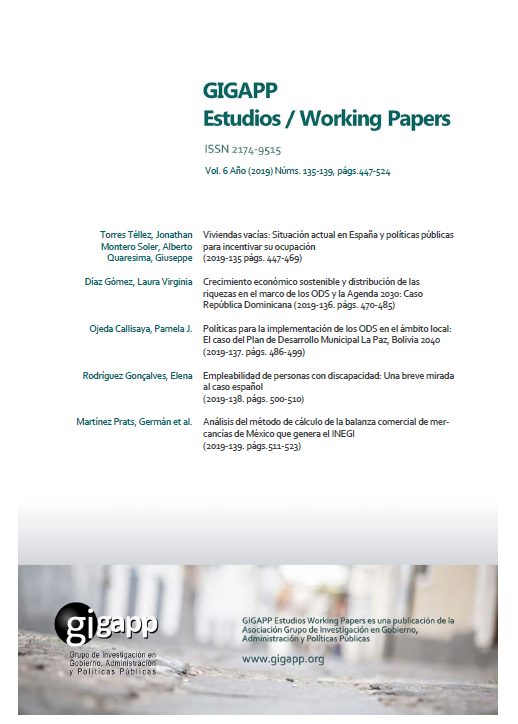Employability of people with disabilities: A brief look at the Spanish case
Abstract
"Leave no One behind" is the United Nations principle that sets out clearly in a few words the need to include in all citizens, including people with disabilities. This work explores this topic. In Spain, 1,840,700 people of working age have some type of recognized disability, which represents 6.1% of the Spanish population of working age. All these people have something or much to contribute to society, they have diverse capacities that must be discovered and used for a common purpose: the growth and improvement of the society in which we live. The question is, paraphrasing Manuel Arenilla: "How much talent of these people are we able to lose?"
Downloads
References
Boletín Oficial Del Estado, del Ministerio de la Presidencia y para las Administraciones Territoriales (2018): Código de la Discapacidad (dos tomos), colección: Códigos, materia: Derecho constitucional, edición: Agencia Estatal Boletín Oficial del Estado.
Boletín Oficial Del Estado, Real Decreto Legislativo 1/2013, de 29 de noviembre, por el que se aprueba el Texto Refundido de la Ley General de derechos de las personas con discapacidad y de su inclusión social, BOE, número 289, de 3 de diciembre de 2013, páginas 95635 a 95673.
Comisión Europea (2010): Estrategia Europea sobre Discapacidad 2010-2020. Un compromiso renovado para una Europa sin barreras, Bruselas: Comisión Europea. Comunicación de la Comisión al Parlamento Europeo, al Consejo, al Comité económico y social europeo y al comité de las regiones, consultado en abril de 2018 y disponible en: http://eur-lex.europa.eu/LexUriServ/LexUriServ.do?uri=COM:2010:0636:FIN:es:PDF
Comité De Representantes De Personas Con Discapacidad: Informe final sobre Horizonte Accesibilidad 4 de diciembre 2017 (2017), consultado en agosto de 2018 y extraído en: https://www.cermi.es/es/actualidad/novedades/informe-final-horizonte-accesibilidad-4-12-2017
Congreso De Los Diputados: Constitución Española y Reglamento del Congreso de los Diputados (2001), edición revisada por las Cortes Generales.
Instituto Nacional De Administración Pública (Inap) (2016): Libro Blanco sobre acceso e inclusión en el empleo público para personas con discapacidad, Edición: Instituto Nacional de Administración Pública.
Instituto Nacional De Administración Pública, nota de prensa sobre curso que se impartió en dicho organismo sobre Discapacidad en el Entorno Laboral, consultado en abril de 2018 y extraído en: http://www.inap.es/alfresco_pack-portlet/alfresco?pathInfo=%2Fd%2Fd%2Fworkspace%2FSpacesStore%2Faa917618-c92e-43ee-bf48-86a3fdbdbf3e%2FNota_Curso_MOOC_Discapacidad_Entorno_Laboral.pdf
Instituto Nacional De Estadística (2018): Nota de prensa en relación a la Encuesta de Población Activa correspondiente al segundo trimestre del año 2018 (en línea): http://www.ine.es/daco/daco42/daco4211/epa0218.pdf, acceso julio de 2018.
Instituto Nacional De Estadística (marzo de 2013): Informe sobre El Empleo de las personas con discapacidad 2011
Ministerio De Sanidad, Política Social e Igualdad (2011): Estrategia española sobre discapacidad durante el período 2012-2020, disponible en: https://www.msssi.gob.es/ssi/discapacidad/docs/estrategia_espanola_discapacidad_2012_2020.pdf
Ministerio De Sanidad, Política Social e Igualdad (2011): Plan de Acción de la Estrategia española sobre discapacidad durante el período 2014-2020, aprobado por Acuerdo del Consejo de Ministros el día 12 de septiembre de 2014 publicado por el Ministerio de Sanidad, Servicios Sociales e Igualdad, Secretaría de Estado de Servicios Sociales e Igualdad, Dirección General de Políticas de Apoyo a la Discapacidad, consultado en abril de 2018 y disponible en: https://www.msssi.gob.es/ssi/discapacidad/docs/plan_accion_EED.pdf, Madrid: Real Patronato sobre Discapacidad.
Naciones Unidas (13 de diciembre de 2006): Convención sobre los derechos de las personas con discapacidad (en línea): http://www.un.org/esa/socdev/enable/documents/tccconvs.pdf, acceso julio de 2018.
Oficina De Atención A La Discapacidad (2016): Informe Anual sobre Discapacidad, consultado en línea, agosto de 2018: http://www.oadis.mscbs.gob.es/informesOPE/Ano2016/PDF/Informe_Anual.pdf
Organización Mundial De La Salud (2011): Informe Mundial sobre la Discapacidad, Ginebra: Organización Mundial de la Salud.
Revista Digital Ticbeat, artículo “La Inteligencia Artificial creará más empleos de los que destruirá en 2020”, consultado en línea en septiembre de 2018 a través del enlace: http://www.ticbeat.com/innovacion/inteligencia-artificial-creacion-empleo-2020-gartner/
Servicio Público De Empleo Estatal. Informe del Mercado de Trabajo de las Personas con Discapacidad, 2019 a nivel estatal del Servicio Público de Empleo Estatal. Consultado en línea en septiembre de 2018 a través del enlace: http://www.sepe.es/contenidos/observatorio/mercado_trabajo/3206-1.pdf
Copyright (c) 2019 Elena Rodríguez Gonçalves (Autor/a)

This work is licensed under a Creative Commons Attribution-NonCommercial-ShareAlike 4.0 International License.
Those authors who have publications with this journal, accept the following terms:
a. Authors will retain their copyrights and guarantee the journal the right of first publication of their work, which will be simultaneously subject to the Creative Commons Attribution-NonCommercial-ShareAlike 4.0 International (CC BY-NC-SA Recognition License). 4.0) that allows third parties to share the work as long as its author and its first publication are indicated in this journal.
Under this open access license, readers (users) can:
- Share — copy and redistribute the material in any medium or format
- Adapt — remix, transform, and build upon the material
Under the following terms:
-
Attribution — Users must give appropriate credit, provide a link to the license, and indicate if changes were made. You may do so in any reasonable manner, but not in any way that suggests the licensor endorses you or your use.
-
NonCommercial — Users may not use the material for commercial purposes.
-
ShareAlike — If remix, transform, or build upon the material, users must distribute your contributions under the same license as the original.
- No additional restrictions — Users may not apply legal terms or technological measures that legally restrict others from doing anything the license permits.
b. Authors may adopt other non-exclusive license agreements for the distribution of the version of the published work (eg: deposit it in an institutional telematic archive or publish it in a monographic volume) provided that the initial publication in this journal is indicated.
c. Authors are allowed and recommended to disseminate their work through the Internet (e.g. in institutional telematic files or on their website) before and during the submission process, which can lead to interesting exchanges and increase citations of the published work. (See The effects of open access).



